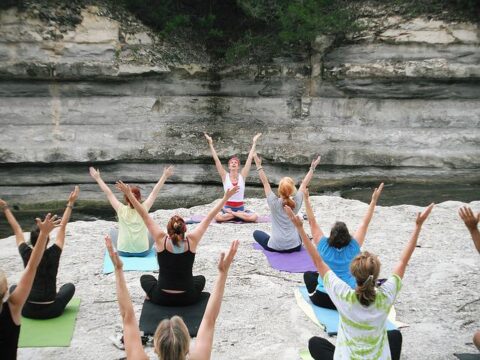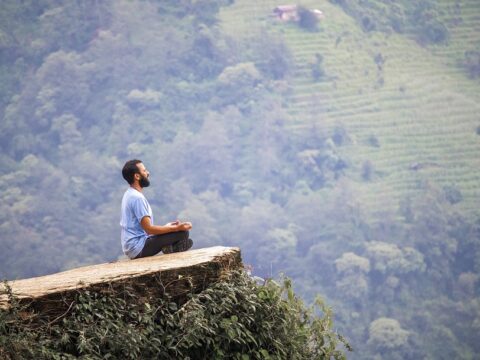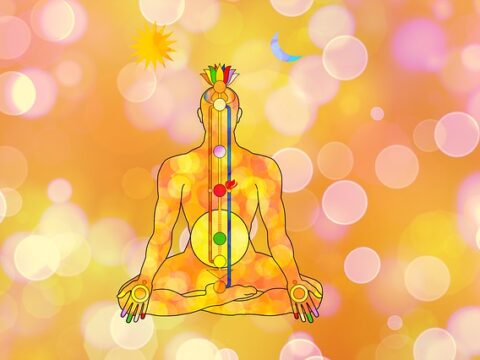Can yoga help with lower back pain? Back pain can have various causes, including mechanical problems, systemic problems or diseases. Fortunately, most cases can be treated at home or with a simple exercise programme. However, if the cause is not obvious, you need to see a doctor as soon as possible.
If you need medical help, understanding the anatomy of the lower back can help you communicate effectively with your doctor, physiotherapist and yoga teacher.
Podcast
Most lower back pain is caused by a pulled or strained muscle. Treatment may include non-steroidal anti-inflammatory drugs, which suppress inflammation and reduce pain and fever. Treatment can also be done with the cooperation of a doctor, physiotherapy and yoga by putting together a series of exercises.
Lower back pain can be a sign of other health problems. For example, it may be a symptomless condition caused by an injury to the lumbar spine.
However, if the pain is a symptom of a spinal problem, a more invasive test may be needed. In addition to X-rays, MRI and CT scans of the lower back are often helpful in detecting abnormalities of the spine.
What are the different types of low back pain?
Non-specific low back pain
Non-specific low back pain is a condition that does not have a specific cause. It is not caused by a disease such as arthritis, but is the result of overstretching a muscle or ligament. It can also be due to a problem with the small facet joints between two vertebrae. It is difficult to determine the exact cause of non-specific low back pain because there are no tests to confirm the condition.
Non-specific low back pain is a common condition. According to statistics, about 8 out of 10 people suffer from it at some point in their lives. It is not usually caused by a major problem or disease and can be very mild or severe.
The usual treatment for non-specific low back pain is to stay active and use painkillers to relieve the pain. Although the pain usually goes away on its own after a week or two, it may recur from time to time. In severe cases, the pain can become chronic.
Pain in the nerve roots
If you have pain in your lower back, legs or buttocks, you may be suffering from nerve root pain.
This type of pain usually goes away on its own over time, but some people need to be im treated.
A doctor can help you get the right diagnosis. Your doctor will ask you a series of questions to determine if your pain is sciatica or something else.
There are several ways to diagnose sciatica, including X-rays and magnetic resonance imaging (MRI). X-rays use invisible electromagnetic rays to create images of the internal structure of your body. Magnetic resonance imaging (MRI) uses large magnets and radio frequencies to produce detailed images. This technique can show the location of herniated discs.
CT myelograms are another way to diagnose nerve root pain, and electromyography can provide information about your muscle condition.
In most cases, sciatica is a non-surgical condition that usually improves with time and a change in activities.
However, in some cases, more invasive surgical procedures, such as spinal decompression, are required to relieve the pain. Non-surgical treatments for sciatica include heat or cold packs, taking over-the-counter NSAIDs and physiotherapy.
Sciatica is a symptom of degenerative disc disease that affects the sciatic nerve. Medications to relieve pain can also help reduce inflammation around the nerves.
Less common causes of pain
Lower back pain can have a variety of causes, from a bad fall to a car accident. It can also be caused by everyday activities such as carrying a laundry basket. Some of these back injuries occur suddenly, while others develop over time.
If you have pain that gets worse when you sit, it is possible that you have a herniated lumbar disc. Your doctor can diagnose based on your symptoms and medical history to determine the best treatment option.
Muscle tension and pain can also be a cause of lower back pain. These can occur on either side of the lower back. These muscles are affected when you lift, twist or do anything that puts strain on them. A normal X-ray may not detect a fracture, but a CT or MRI scan can help determine if there is an underlying condition.
Other less common causes of low back pain include spondylitis, inflammatory bowel disease or a tumour. These are more serious than non-specific low back pain. Some types of arthritis can cause low back pain.
Osteoporosis is another common cause of back pain, which can also affect joints other than the spine. Physical changes related to the normal aging process can also be the cause of low back pain.
Causes of lower back pain
Lower back pain can be caused by a variety of conditions. One common cause is a herniated disc.
This is when the material inside the disc pushes through the fibrous tissue in the spine. This can cause pain, numbness and weakness in the legs. This condition is most common in men between the ages of 30 and 50. It is usually diagnosed by a neurological examination or an MRI scan.
Common treatments include over-the-counter painkillers and physiotherapy to help the patient relieve the pain. For more severe conditions, surgery may be needed.
A minimally invasive surgery called a rhizotomy (nerve root removal) involves inserting a thin needle filled with epoxy-like glue into a gap in the vertebral body.
Lower back pain can also be caused by age-related degeneration of the spine. A sedentary lifestyle can also contribute to this problem.
Obesity and poor posture can compress the vertebrae. Other common causes of low back pain are obesity, age-related degeneration of the spine and congenital defects.
Arthritis is another common cause of back pain. This condition often occurs in the joints of the legs or arms, but can also spread to the lower back.
Symptoms can be mild or severe and can affect a single leg or both legs. A doctor can diagnose lower back pain and make a treatment plan to relieve the symptoms.
Symptoms of lower back pain
Lower back pain is a common medical problem that affects more people than you might think. Unfortunately, many people ignore the symptoms, which can lead to chronic pain.
However, you can prevent this type of pain if you know your body. If you know what to look for in your symptoms, you can find out the cause of your pain and get the right treatment.
Lower back pain can have a variety of causes, including a serious injury or infection. In some cases, it can even be a sign of cancer. For some people, the pain is chronic, meaning it lasts for months or even years. In these cases, the pain may be constant or intermittent and include numbness, pins and needles or tingling.
The pain may be sharp or dull and radiate from the lower back to the hip or further down the leg. The pain may also be accompanied by a cracking or snapping sound.
The pain may get worse if you move certain parts of your body or if you sleep for a long time. The muscles in your lower back may also become stiff and hard.
Usually, non-specific back pain subsides within a few weeks. However, you should see a doctor if the symptoms persist or get worse.
4 Yoga exercises to prevent low back pain
If you have low back or back pain, consult a health professional before doing yoga exercises.
Half Twist Sit (Ardha Matsyendrasana)
The half twist sit is an excellent way to correct your posture and calm your mind. It stretches your outer thighs and hips and opens your chest and shoulders. The pose also massages your digestive organs and improves your overall health. This yoga pose can also be used to relieve back pain and heal a herniated disc.
To begin the pose, sit with your right leg on the floor and place your left foot on the floor. Place your right arm on your left knee and slowly rotate your upper body to the left. The rotation should be from the base of the spine to your shoulders. Hold the pose for up to one minute.
Ardha Matsyendrasana is a twisting yoga pose that opens the chest and shoulders. It can also help with lower back pain as it stretches the spine. It also increases energy in the body and relieves symptoms associated with prolonged sitting and excessive use of technique.
There are many variations of this pose, for example, you can place your right foot under your right knee or place a book under your left foot. Alternatively, you can link your hands to make the twist deeper.
Lying Twist (Jathara Parivartanasana)
Jathara Parivartanasasana, also known as lying twist, is an exercise for the whole body. In this twisting yoga asana, you bend forward and twist the body at the same time. The pose is an effective way to improve balance and flexibility and can relieve back pain.
This pose helps to release toxins from the body, dispels fatigue and promotes a strong lower back. It also improves digestion and regulates body heat. In addition, it promotes self-esteem and self-confidence. The regular practice of this yoga pose can help reduce stress and improve mood.
The aim of this pose is to stretch the legs and address the core muscles. First place the hands at the sides and then bend the knees towards the chest. As you bend the knees, rotate the lower back and spine and the head and shoulders should be erect.
Standing twist (Parivrtta Parsvakonasana)
Standing twist is a complex twisting posture that requires practice to perform correctly. People suffering from hip, back or pelvic problems should not perform this pose. They should also make sure that both feet are firmly planted on the floor.
To perform Parivrtta Parsvakosana correctly, the sternum should form a line with the left thumb. It is also important to remember that a tense spine prevents proper rotation. If you have difficulty with this posture, you should perform it with a support. A firm block is a good way to support your back during this asana.
Parivrtta Parsvaksana is a great exercise for strengthening the body and relieving stress. It exercises many important muscles, including the hip flexors, and strengthens the lower back and shoulders. It is also beneficial for osteoporosis and constipation.
Pregnant women should avoid this pose as it puts a lot of strain on the abdomen and prevents proper breathing. Pregnant women should also avoid twisting poses as they can strain the lower back. People with high blood pressure should not do the Parivrtta Parsvakonasana yoga pose.
To make this pose more challenging, you can place your right hand outside your left foot. This is a challenge for your balance. In this case, use a block to keep your balance. You can also place a block under your left hand if you need to.
The twisted plough (Parsva Halasana)
The twisted plough requires the practitioner to bend their neck and shoulders. To achieve this posture, the body should be supported by a cushion or blanket under the shoulders. The legs should be straight and the feet must rest on something flat.
Parsva Halasana is a restful pose. It strengthens the tibialis anterior, which stabilises the feet and calves. It also stimulates the small chakras. It is not recommended for people with serious health problems. However, older people can practise it safely with some guidance.
Parsva Halasana is a more advanced form of Halasana. Its name is derived from the Indian word “hala”, which means “plough”. This posture helps to rejuvenate a certain part of the body by stretching and tightening the spinal nerves. The posture also helps to improve the alignment of the spine and promotes blood circulation.
When practising this yoga pose, beginners may not be able to touch the floor. In such cases, they can use a wall or chair to support their feet on. In addition to the floor, they can also use bolsters or a cushion for stability. The pose can be held for one to five minutes.
Begin the pose by lifting your pelvis and lower back. Then roll down one vertebra at a time until your body lies flat on the mat. If necessary, you can bend your knees or support your hips with your hands.




